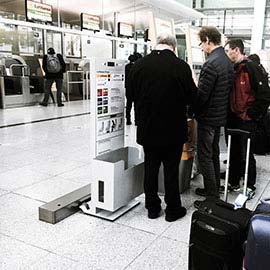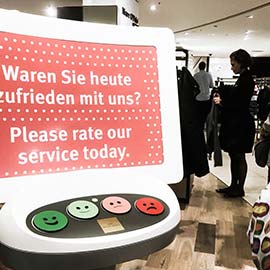Do it yourself - who still needs employees?
They are not getting paid, they don’t need an office or a works council. Many businesses wish they had such employees. Surprise – they do! They’ve actually been around for even longer than commonly assumed and they’re more productive than ever. In steadily increasing numbers they are coping with already familiar challenges and beyond that they are trying to complete necessary tasks in new areas of activity. There’s just one thing – they’re not called employees but customers.
Many businesses are outsourcing their jobs to their customers thus turning them into: commercial employees, banking staff, airline employees, designers, product experts, innovators, brand ambassadors or simply unpaid, informal part time employees who become involved in the operational systems and processes. Quite a lot of what previously used to get done by employees of a business, is being done by customers themselves nowadays. And this trend is growing rapidly!
Help yourself, self-service, do-it -yourself – three frequently used terms. Encouraged to ‘do-it-yourself’, customers are turning into a willing labour force and barely realize how much of their time they are actually ‘donating for free’. Does that mean that customer service no longer matters today since it is the customer at our service?
Until the 1960s the concept of self-service was virtually unknown in Europe, there were no supermarkets. Grocery shopping until then was a relatively time consuming and tedious affair. To get the various goods one had to actually go to several different shops, where the desired products were fetched individually for every single customer, manually weighed, packaged and billed. A sales transaction then took a lot longer than nowadays - yet, on a positive note, every shopping trip was also a social event. The idea of self-service originated in the USA and – after a few teething problems - spread at an incredibly rapid pace. Many retailers were initially sceptical and feared that through the concept of self-service they were going to lose touch with their customers and they were also worried about theft. Also, where customers all along relied on the recommendations of a retailer, they suddenly found themselves left on their own. And all of a sudden it was the goods and products that had to market and sell themselves, attract attention and present themselves appealingly in order to be purchased.
The first self-service restaurants were fast food chains that began to mushroom in the USA in the early 1950s. McDonald’s perfected the art of the fast food service through efficient and rational product manufacture, strict division of labour in the kitchen, self-service and the option of take-away.
The do-it-yourself (DIY) trend also began in the 1950s influenced by the arts-and-crafts movement in the UK and eventually spread to Europe, fast becoming popular on the entire continent. This new trend was later characterized by the belief in self-empowerment, self-organization, improvisation, individual initiative and a frequent mistrust in established authorities, passive consumption, industrialised products and manipulation by the mass media. At the same time there was an ongoing commercialization of the DIY concept, for example with the opening of the first real hardware store „Bauhaus“ in Germany. This way a host of customers turned happy ‚do-it-yourselfers‘.
But why are customers willing to work on their own responsibility, voluntarily and at any time for free? There are three reasons that could possibly explain this motivation.
- Customers often resort to self-service options due to the desire for more flexibility in terms of time and location. The trip to the nearest branch, considering the opening hours of course, is no longer necessary – thanks to online services. The smart phone which is always at hand is increasingly becoming a key technology in meeting the growing demand for more flexibility, simpler access and better availability – online.
- For many customers it is a question of saving costs and/or time, because they find the traditional service provided by a sales assistant often as barely efficient. Active participation through self-service makes these customers feel that they are receiving a better deal since they are in control and therefore believe they are more effective, efficient and smarter. Some customers, however, want to reduce their costs by doing some of the work themselves – for instance craftsman services and artisan work – often quite a challenge for businesses.
- Yet others appreciate the active participation and involvement in the service process, since it gives them a feeling of control and self-reliance. The customer is independent from the employees of a business. An added advantage is the fact that customers need not fear to be misunderstood nor do they run the risk of appearing ridiculous in front of employees simply by asking questions.
When it comes to self-service usability is definitely a key factor for the customer – that is issues such as clarity, transparency, serviceability and easy handling, speed, reliability and security.
A variety of diverse self-service options have long become an important component of the “customer journey” and therefore have a direct impact on the individual customer experience, whereas factors such as friendliness, empathy, competence and expertise of the staff rank among the top criteria in direct customer service.
In times when customer orientation is one of the key success factors, customer service inevitably moves into focus and becomes central to all commercial activities. The challenge for businesses lies in achieving the economic balance between service excellence, customer satisfaction and profitability. Automated self-services incur approximately only 15% of the costs that a personal customer contact would figure in the accounts, however, they would have to be more customer friendly and designed in a more experience-oriented manner in order to sustainably improve and enhance the “customer journey”. With regard to the ongoing digital transformation in business enterprises there is still an enormous potential yet to be tapped into.
Just to give an example – my last flight, short haul. After the initial almost compulsive visit to the comparison portal “checkfelix or check gar nix” I eventually and inevitably ended up at the airline’s own website, being the seasoned airline customer that I am, in order to book my flight. Works quite well meanwhile actually, unless you are unlucky enough to find the airline’s server hopelessly overloaded which in consequence results in the immediate disruption of the currently running payment transaction by credit card. Well, great! All of a sudden you find yourself miles away from the path of digitalized autonomy and thrown into a dizzying maze of customer relations, booking and other similar information and contact numbers. After what seems to have been ages and against the backdrop of corporate music, advertising and motivating slogans intended to keep the client on hold entertained and relaxed one is finally put through to a more or less friendly call centre employee who … well, need I say more … Luckily though an experience I have been spared from this time around. Everything must have gone well this time and the confirmation e-mail gives me the confidence and security that – as temporary travel expert – I seem to have succeeded in accomplishing the task. Of course, prior to starting my journey I sort out my check-in, select a seat of my choice, confirm all security relevant questions and print my ticket – no less professional nor less friendly of course to myself than any average check-in employee would have executed the task. On arrival at the airport I notice pretty quickly that the “baggage drop-off” counters, which have all along been manned by real human workforce, have since been automated and converted into baggage-upload-machines.
No problem, even at this step of the entire process and as motivated part-timer I proceed to attach the tape with the barcode for my destination and release my suitcase into the bottom of the baggage transportation. This “do-it-yourself” actually started already with weighing vegetables on your own at the supermarket, didn’t it? Just somehow came to mind. Interestingly, at the security check-point I meet up again with real humans. It seems that unpleasant tasks apparently remain to be executed by employees. On arrival at the gate and due to a delay in departure which the lady behind the counter didn’t even bother to point out, but which I found out about thanks to my meticulous and thorough electronic check-in and additional notification by e-mail I find myself left with extra time to hang around waiting. Well, there you are, finally at the gate and you suddenly feel this real energy slump. Only a while ago, when you did everything on your own, everything happened much more reliably and faster – and now, all of a sudden? What is the added value of the lady behind the counter? All passengers have already checked in online and are waiting with their boarding passes either in print or on their smart phones so that nothing stands in the way of boarding the plane. When boarding finally starts, the employee at the counter functions only as observer, at best as usher coordinating the queue of passengers who are anyway scanning in their boarding passes on their own in order to proceed through the gate. Finally, on board of the aircraft you suddenly realize how barely necessary - save for emergencies – flight attendants actually are. After a monotonous „Welcome, hello, welcome, hello, “you finally put away your hand luggage, again on your own and take your seat. You would probably have picked up newspapers or magazines at the self-service counter at the gate too. After a further rather uninspiring “safety demo” , snacks will be served ‘canteen-style’, snacks that no one really finds very tasty or appealing anyway, followed by cold and hot drinks on offer. A task that would certainly function equally well if offered as a self-service option on board. After landing you just need to wait for your luggage and hope that you only need to find your way to the lost&found counter in the rarest of exceptions –by the way, an unpleasant task again that has to be carried out by real human beings.
The level of co-operation as a customer has become a fixed component of today’s service society and businesses can “employ” their customers in any one or more of the following five areas:
- As part-time employee there are relatively few options for the customer to know what proportion of contribution to the overall performance process is expected of him. These are often self-service concepts for customers who are prepared to render a fairly high contribution, largely to save cost. What would IKEA be without their customers in their role as self-advisors, planners, warehouse staff, cashiers, forwarding agents, carpenters and packaging recyclers.
- As information providers for the business through involving customers in surveys, complaints management or social media management by means of sharing particularly positive but also negative customer experiences on the other hand, and also, of course, as product or service expert for other customers of the business enterprise. Who hasn’t received the following request from amazon for instance: „ Could you, as buyer of [product/service] rate our … to assist this customer with his question?”
- As brand ambassadors, because more and more customers rely in their decision making on the personal recommendations of close friends. Well then, why not make customers promoters of just purchased products or services straight away? This kind of referral marketing - through credible, non-remunerated brand ambassadors – usually works through direct personal sharing or large scale forwarding of chain messages of relevant contents on Instagram, Facebook, Youtube, etc. entirely in line with „You’ve gotta see this!“ This way shopping and buying are changing into a common social undertaking thus turning the once consumers into creative sales assistants.
- As Co-producer or prosumer the customer is directly integrated into the service creation of service processes – for example the booking and purchase of tickets or E-banking – as it is now the customer who carries out tasks previously executed by company employees. This form of customer involvement would also apply to the specific individual design or configuration of a car or the personal design of a T-shirt.
- As Co-Innovator innovative services or designs are developed in close co-operation with the customer. This form of collaboration on an equal footing is often perceived as appreciation by the customer and in the ideal case scenario both parties would benefit from the availability of more demand-oriented products or services. Quite often companies also provide the toolkits, beta- or developer versions of their products so that customers can actually carry out each individual step on their own and also give continuous feedback so that the only step that remains to be taken by the company is the actual production and distribution of the products so developed. The “user-generated versus designer-generated products” shows which advantages open innovation and crowdsourcing can offer to trade businesses. In co-operation with the Japanese retailer Muji researchers analysed whether there were significant differences in sales figures of products that were designed by consumers and those designed in-house. The astounding results: already in the first year of introducing a product the sales profits of user generated objects was three times that of the same but in-house designed product. These effects intensified over the years. Three years after market introduction, according to the authors there were significantly more products designed by customers that “survived” than those that were developed by designers.
With their many different „do-it-yourself“ needs and demands customers are not actually opting out of the traditional economic system, but they do expect adequate service quality at all those contact points at which they interact directly and one-on-one with employees of the business and naturally desire a sustainable and positive customer experience.
Obviously, businesses will have to watch their costs, however, those who focus solely on the digital transformation with all its manifold possibilities for new self-service concepts run the risk to lose sight of the overall strategy. Those who do not recognize what added value the individual human contributes to the service society must not be surprised, if customers turn away and try to make do without the business and get by on their own. It doesn’t work that way all the time, however, and it is precisely for this reason that the services of qualified expert staff are required. Emphatic and passionate employees who create inspiring and impressive customer experiences! Something people more and more wish and long for in a world that is increasingly driven by technology, because in the midst of all this digitalisation sensuality, the tangible and haptic, the specific and sensitive are making a triumphant return. The traditional successful symbiosis between man and machine must make way for a new range of future models that allow room again for human real-life emotions.



























